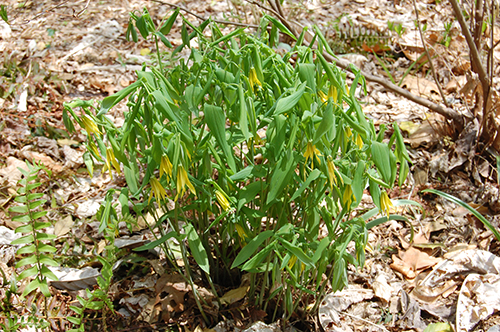
Picture 1. Uvularia grandiflora in a woodland garden.
Without a doubt, there is no shortage of color throughout April and May. From the heights of flowering trees to sprawling groundcovers, color abounds. This also implies that for a spring bloomer to be garden worthy, it must have bold blossoms or colorful foliage. Or, at least that was my viewpoint when I first began to garden. As time passed, I began to better appreciate the small nuances that make for a great garden plant without the need for audacious flowers or brazen foliage. It was sometime in the spring of 2009 when I first encountered Uvularia grandiflora, commonly known as Merrybells or Bellwort. Its delicate yet eye-catching constitution, as seen in Picture 1 began my slow but steady appreciation for the delicate nuances of spring beauty!
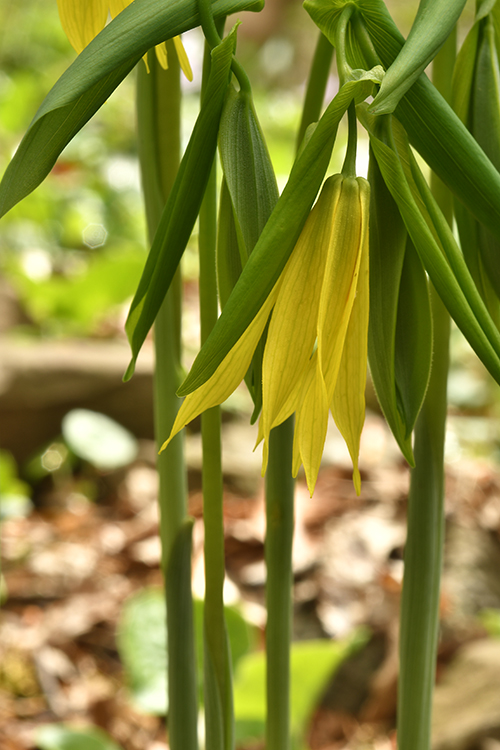
Picture 2. Uvularia grandiflora flower.
The genus Uvularia contains five species, all of which are native to Eastern North America. Once considered a member of the Liliaceae or Lily Family, the genus has been shifted to the Colchicaceae or Colchicum family, a family best known for the autumn flowering Colchicum bulbs. The genus was named by the Swedish botanist Carl Linnaeus (1707–1778) in 1753 and its roots came from the Latin ūvula, meaning little grape. Obviously, this was also the inspiration behind the name for the small organ found at the back of our mouth! For the plant, the inspiration was sparked by either the dangling yellow flowers or perhaps the hanging fruits that follow, which do resemble a small green grape. The species epithet, meaning 'large flower' refers to the impressive 1½" long flowers, as seen in Picture 2. The species was named in 1804 by Sir James Edward Smith (1759–1828), an English botanist and founder of the Linnaean Society, which is still active and devoted to the study of natural history.
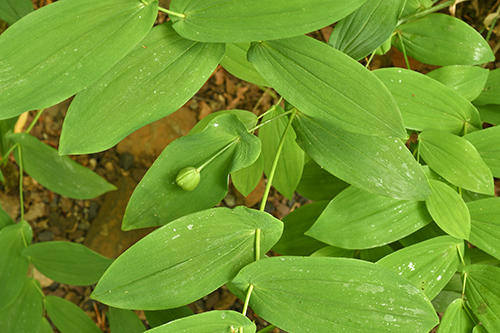
Picture 3. Perfoliate leaves and seed pedicel.
The large flowers consist of six slightly twisted tepals. A tepal results when the inner whirl of petals and outer whirl of sepals look virtually identical – in this case there are three of each. Sepals are modified leaves that cover the floral bud and are normally insignificant to the display. However, for a number of plants, including Magnolias, they help to enhance the floral display. The 'shoulders' of the dangling flowers are dark green with a light green central blush just below the shoulders and bright yellow margins that helps to highlight the tepals. In addition, several light green lines run from base to tip of the tepals. At the flower's center lie three curled female styles and associated pollen gathering stigmas that loosely resemble a jester's hat. The three styles are in turn connected to a three chambered ovary. Following the senescence of the six tepals, the seed capsules are readily seen hanging above a leaf (as seen in Picture 3) until it shatters in August, releasing the now ripened seed.
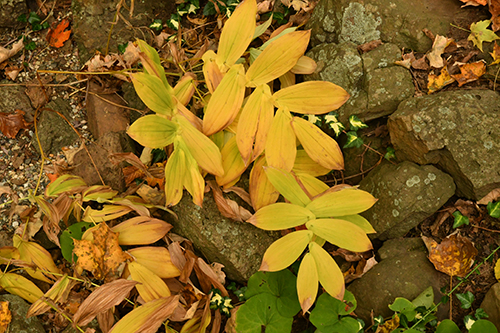
Picture 4. Fall color of Uvularia.
Not to be outdone, the foliage is equally as ornamental. It is bright green in spring, deepening to a dark green come summer and transitioning to a bright yellow in October (Picture 4). Similar to the hanging flowers, the foliage has a dramatic, somewhat flaccid appearance in early spring that becomes firmly outstretched come late May. Reminiscent of the green lines in the tepals, the leaves have deeply incised veins or 'nerves' that run from base to tip, giving the leaf a beautiful texture. The leaves are also perfoliate, a development whereby the stem literally appears to grow through the base of the leaf, as seen in Picture 3. Intriguingly, the pedicel or stem of the developing seed capsules also appears to pass through the leaf, enhancing the subtle beauty of this plant. Equally endearing is the zig-zag appearance of the stem between each leaf, particularly near the tips of the stems. A subtle yet visually appealing plant whether in or out of flower!
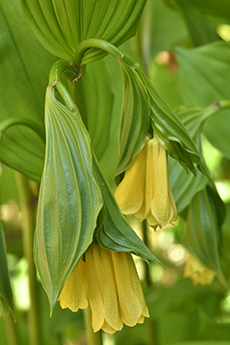
Picture 5. Disporum uniflorum flower and textured foliage.
The plants spread by producing short rhizomes, yielding dense clumps that slowly expand in a very mannerly fashion. By no means aggressive, the plants are best grown in dappled shade in humus rich soils mulched with fallen leaves. Plants will readily grow to 2' tall and where happy, seedlings will gradually appear over time.
A related genus that is an equally worthy addition for the woodland garden is Disporum. Very similar to Uvularia and at one time included within this genus, Disporum is a genus of around 20 species native to areas throughout Asia. Commonly known as Merrybells or Fairy Bells, it too is a member of the Colchicaceae family. The genus was first named in 1812 by the British botanist Richard Anthony Salisbury (1761–1829). The name comes from the Greek Dis for two and Sporus for seed, describing how there are usually two ovules or seeds in each of the three chambers within the ovary. Of course, botany is not without controversy and some authorities believe Salisbury did not properly describe the genus, preferring the description published by the Scottish botanist David Don (1799–1841) in 1825. I suspect this controversy will never be totally resolved.
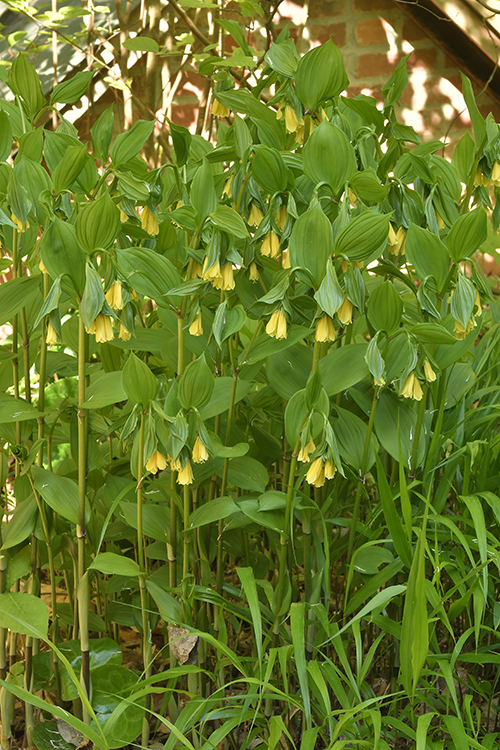
Picture 6. Disporum uniflorum plant in bloom.
Of the numerous species available commercially, I really appreciate the garden worthiness of Disporum uniflorum, commonly called Yellow Fairy Bells. It is often, yet improperly sold as Disporum flavens. It is native to forests located primarily in Korea along with regions in neighboring China at elevations of 300–7,500 feet. The species epithet refers to how the dark yellow flowers typically appear singularly, although it is not uncommon for them to be arranged in clusters of two or three. The species was named in 1875 by the well-respected English botanist John Gilbert Baker (1834–1920) and published with the assistance of an English colleague, Spencer Le Marchant Moore (1850–1931). In 1934 the name of Disporum flavens was penned by the Japanese botanist Masao Kitagawa (1910–1995). This was a logical species epithet, since flavens is from the Latin flāvus meaning yellow and distinctly describes the flower (see Pictures 5 and 6). However, once a plant is properly named and published, all subsequent names are not accepted.
Yellow Fairy Bells blooms about 2–3 weeks later than its North American cousin Uvularia grandiflora, as the flowers typically appear at the end of April or early May. The plants share a similar arching habit, although the flowers and foliage of Disporum have a more lustrous and visually thicker texture. The dark yellow bell-shaped flowers once again consist of six tepals, although the tips are rounded rather than pointed as with those of the Uvularia. The flowers appear from the downwardly arching tips of the stems, with the surrounding leaves having very prominent arcuate veins that are seen running from base to tip. Reflective of the foliage and similar to Uvularia grandiflorum, the tepals have light green lines that run from the base to tip when studied closely. The overall effect appears very much like clusters of small yellow bells that mischievous woodland fairies will peal upon the appearance of visitors! Perhaps an overactive imagination, but it does give the woodland garden a surreal feeling.
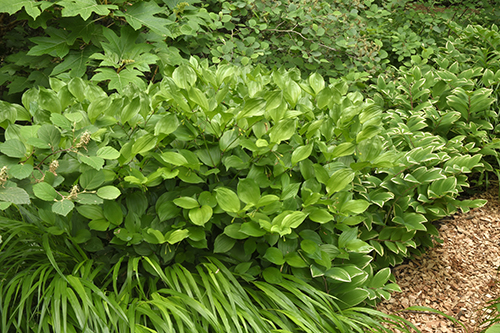
Picture 7. A 20-year old plant of Disporum uniflorum.
As the flowers fade, small rounded green berries become apparent, which gradually transition to dark purple when mature. Like its North American cousin, plants expand by short and thick rhizomes, producing dense and well-behaved colonies. In fact, after 20 years the plant in Picture 7, which began as a 4" pot has developed into a 30" wide clump. Pictured with Polygonatum odoratum 'Variegatum' (Variegated Solomon's Seal) in the background, the Fairy Bells still has no need for division nor has it yielded any seedlings.
Another very popular, yet dramatically different appearing Fairy Bells is Disporum sessile, a native to woodlands of Japan from sea level to mountainous elevations of 4,500 feet! Interestingly, it was originally named Uvularia sessilis in 1784 by the Swedish botanist and medical doctor Carl Peter Thunberg (1743–1828), illustrating how closely the two genera appear. The plant was shifted to the genus Disporum in 1829 by the Austrian botanist Joseph August Schultes (1773–1831) and his son Julius Hermann Schultes (1804–1840). The species name refers to the much-reduced petiole or 'leaf stem', giving the leaf blade the appearance of being directly attached to the stem. Compared to its afore mentioned cousin, the leaf veins are still evident, although not as deeply pronounced and the leaves are slightly more linear. A more noticeable difference is the bright white color of the flowers, particularly the shoulders of the flowers with the color transitioning to an off-white green blush towards the tips of the tepals (as seen in Picture 10).
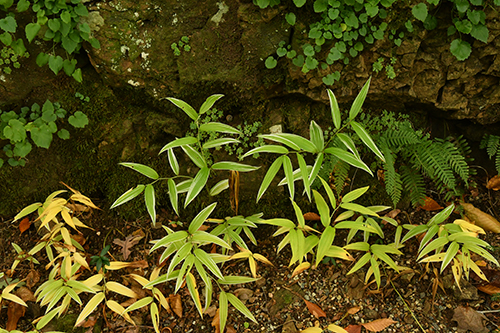
Picture 8. Disporum sessile 'Variegatum' in fall color.
Another major difference is the habit of the plant. The stolons of this species are far more slender with longer lengths between the nodes or buds. This results in a plant with much greater distances between the leafy stems and is far less dense than Disporum uniflorum (as seen in Picture 8). Granted, this habit may not initially sound as attractive, but it allows the plant to interweave between lower growing plants, producing a very attractive effect. Enhancing the impact is the variegated form Disporum sessile 'Variegatum' with very attractive white and green variegated foliage. This form provides a wonderful glow to the shady garden and mixes beautifully with the blue flowered Brunnera macrophylla (Picture 9) and white variegated woody shrubs such as Orixa japonica 'Pearl Frost', or both! The variegation varies from a slender white margin to dramatic markings throughout the leaf. Unlike many variegated plants, the variegation remains strong throughout the summer and come fall the leaves transition to a nice butter yellow (Picture 8).
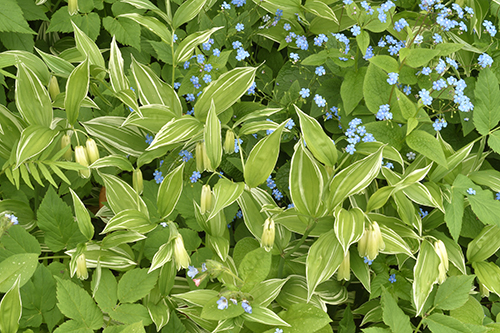
Picture 9. Disporum sessile 'Variegatum' with Brunnera macrophylla.
Separated by the Pacific Ocean, Uvularia and Disporum are related woodland plants that share numerous physical similarities yet each genus and species has their own distinctive and subtle beauty. Oddly, both genera are dramatically underused and in consideration of their well-behaved garden manners, should be used by more gardeners to grace their woodlands. After all, who would not want these attractive bell-like flowers subtly pealing the beauty of spring for all to hear – and see!
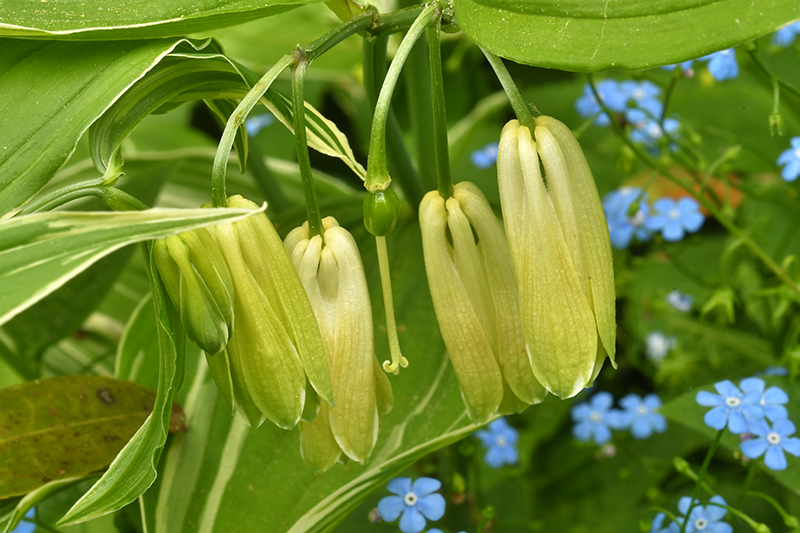
Picture 10. Three curled female styles, seed pod and tepals of Disporum sessile 'Variegatum'.

